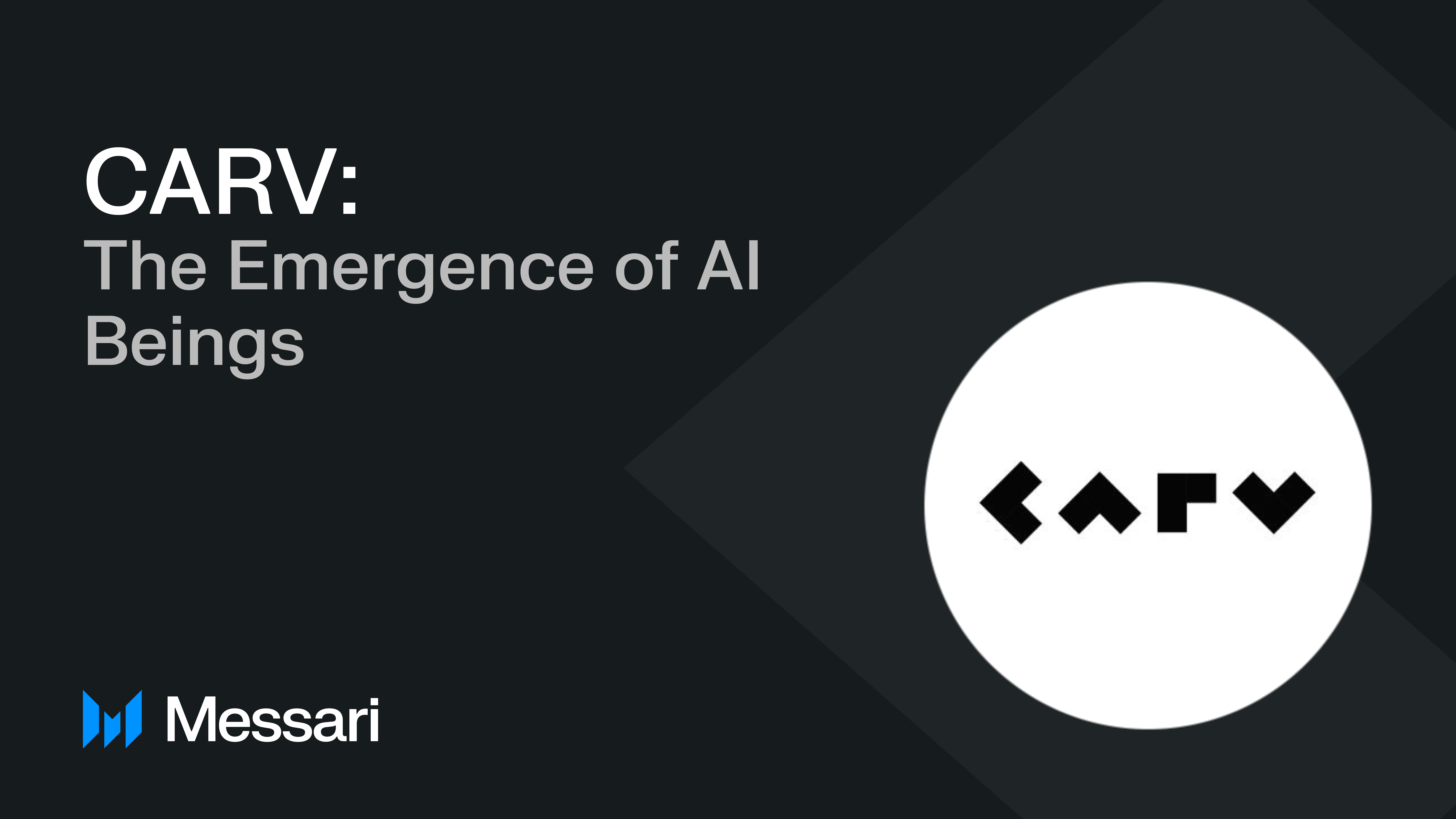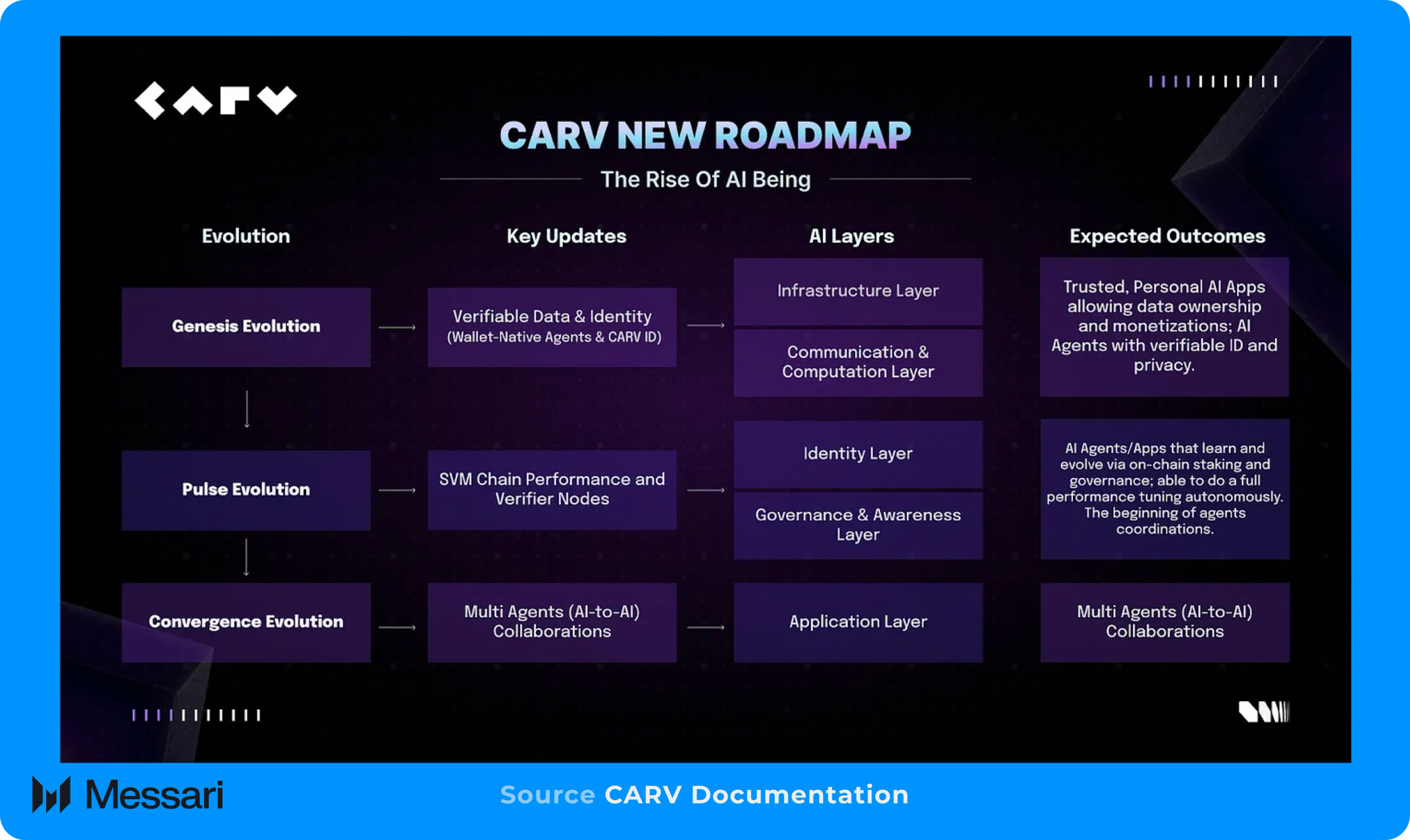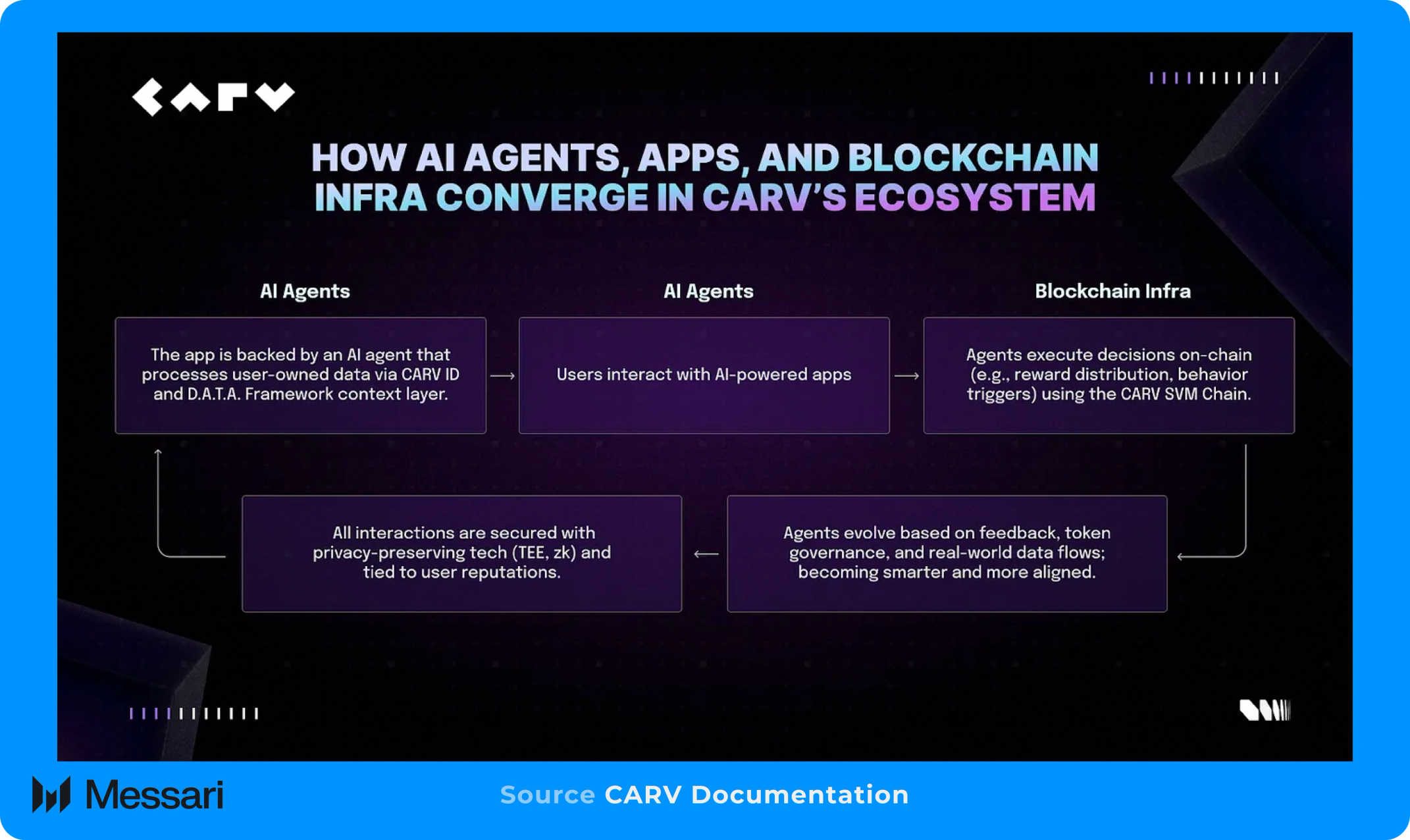Physical Address
304 North Cardinal St.
Dorchester Center, MA 02124
Physical Address
304 North Cardinal St.
Dorchester Center, MA 02124

CARV was founded in 2022 with the aim of enabling users to regain ownership and control over their digital identities and data, particularly within the gaming sector. That same year, CARV launched CARV Play, a platform that aggregates Web3 gaming experiences and reward-earning activities in a unified interface. In 2023, the team introduced CARV ID, a cross-platform identity protocol built on the custom ERC-7231 standard, allowing users to merge their Web2 and Web3 identities into a verifiable, NFT-based profile. This identity model underpins the CARV Protocol, a data and identity layer that facilitates secure, permissioned data sharing and monetization across chains.
In early 2025, CARV expanded its infrastructure into AI agent execution with the testnet launch of the CARV SVM Chain and enhancements to the D.A.T.A. Framework. The CARV SVM Chain is a modular Layer-2 that uses a decoupled Solana Virtual Machine (SVM) for execution and is designed to settle on Ethereum. It is optimized for high-throughput, low-latency processing of AI agents and agentic applications. The D.A.T.A. Framework supports structured retrieval of onchain and offchain user-consented data supplied through CARV ID and is used by agents to personalize behavior and interactions. CARV’s hybrid architecture utilizes Trusted Execution Environments (TEEs) and zero-knowledge proofs (ZKPs) to ensure that offchain agent tasks are cryptographically attested before being finalized onchain. A verifier node network is currently live on testnet and is planned to validate these attestations at scale, helping ensure trustless computation without centralized intermediaries. For more information on CARV’s transition into an AI agent ecosystem, refer to the previous Pulse report.
Website / X (Twitter) / Discord / Telegram
In June 2025, CARV introduced a phased roadmap outlining its expansion from an identity and data protocol into a modular infrastructure stack for multi-agent systems. The roadmap describes a series of milestones aimed at enabling onchain autonomous and sovereign agents, which are referred to as “AI Beings,” to operate with persistent identity, shared memory, and adaptive behavior. These agents are expected to interact with users, interpret governance and staking signals, and eventually coordinate with other agents in DAOs and agent-to-agent marketplaces.

The roadmap is organized into three phases of evolution: Genesis, Pulse, and Convergence. Each phase builds upon the last, progressively unlocking more adaptive, collaborative, and sovereign agent behavior. The Genesis Evolution phase is ongoing, with several foundational components of the AI Being Stack already deployed or in active development:
The Genesis Evolution phase establishes persistent identity and agent memory, while the Pulse Evolution phase is expected to introduce real-time responsiveness to staking, governance, and user behavior signals. Convergence Evolution will extend the ecosystem into multi-agent collaboration, including agent DAOs, shared governance infrastructure, and agent-to-agent marketplaces for autonomous service and resource exchange.
Genesis establishes the foundational components of CARV’s architecture for identity-linked agents with persistent memory and verifiable execution.
CARV ID anchors user identity across applications. As of writing, CARV has issued more than 8 million NFTs encoding metadata such as wallet activity and social profiles. This identity layer is being extended to support Agent ID, a verifiable onchain identifier for AI agents that will record execution history, behavioral traits, and task metadata. Reputation scoring is not yet active, but Agent ID is designed to support future integration with a unified reputation graph.
Agents coordinate memory, learning, and resource access through the Model Context Protocol (MCP), a cross-layer protocol embedded across the CARV stack. MCP connects key components such as the CARV SVM Chain, CARV ID, and the D.A.T.A. Framework, allowing agents to access structured, user-consented data and interact with other agents and services. It supports continuity across sessions and enables context-aware behavior by linking identity, execution logic, and data access.
CARV is collaborating with several projects to deploy agent-powered applications across both consumer-facing and protocol-level environments. These agents operate in interactive or background roles depending on the use case, accessing user-approved data through the D.A.T.A. Framework via two query modes: backend-generated and model-generated. Both modes support real-time access to structured onchain and offchain information. Features such as behavioral tagging and semantic filtering are in development to enable agents to classify users and peers by traits like governance participation or staking behavior.

As part of these efforts, CARV has initiated partnerships to extend its agent infrastructure into specialized AI domains:
The Pulse Evolution phase introduces economic awareness and adaptive behavior into CARV’s agent architecture. Building upon the foundations established in Genesis, Pulse enables agents to dynamically interpret authenticated onchain signals, including staking patterns, token delegation, and governance participation. Agents leverage these signals to inform decision-making processes, prioritize user interactions, and align their behavior more closely with user incentives and community governance outcomes.
CARV is developing native support within its SVM Chain, CARV ID, and the D.A.T.A. Framework to allow agents to directly query onchain staking and governance data across multiple tokens. These signals include token balances, delegation power (e.g., vote escrow-style governance), staking durations, and historical voting records. This infrastructure aims to enable agents to prioritize engagement with users whose interests are economically aligned, such as by surfacing content or tasks to users who stake the agent’s own token, delegate governance rights, or actively participate in relevant proposals. These behaviors are authenticated and validated by CARV’s Verifier Node network, leveraging Trusted Execution Environments (TEEs) and zero-knowledge proofs.
During the Genesis Evolution phase, personalization was primarily based on static, historical data supplied by users. In contrast, the Pulse Evolution phase introduces a shift toward real-time responsiveness, with agents adjusting based on ongoing user behavior. These agents will be able to monitor user interactions across various areas, such as staking activity, governance involvement, and patterns of community engagement. Over time, they will incorporate both explicitly stated preferences and implicit priorities inferred from observed actions. For example, consistent participation in governance related to particular services or repeated staking on certain agent types may influence how agents tailor recommendations and prioritize responses.
The Pulse Evolution phase will introduce monetized access to gated datasets provided through CARV ID. Agents must spend CARV tokens to access enriched user-consented data such as detailed behavioral tags, reputation scores, and cross-platform activity. CARV is also actively piloting usage-based microtransactions to enable granular economic interactions between agents and data providers.
Moreover, agents or users who receive veCARV tokens by staking CARV also acquire governance influence, allowing them to submit proposals, participate in voting processes, and shape protocol-level decisions. Governance outcomes, including updates to ecosystem parameters and changes in incentive structures, are systematically relayed back to agents through MCP and the D.A.T.A. Framework. This closed-loop feedback mechanism is expected to allow agents to dynamically adjust task prioritization, data selection strategies, and interaction logic based on evolving governance signals, thereby creating an adaptive ecosystem responsive to community-driven decision-making.

Convergence Evolution is expected to introduce capabilities for autonomous agent collaboration, agent-driven governance, and agent-to-agent marketplaces across CARV’s architecture. Building on the foundations laid in Pulse, agents will be able to coordinate more complex interactions, participate in decision-making processes, and transact directly with each other and users.
This phase is expected to implement a “unified reputation graph,” which is designed to aggregate verifiable claims such as task completion, staking activity, peer attestations, and governance participation. These signals will be encoded in Soulbound Tokens (SBTs) and verified through CARV’s Verifier Node network. Agents will access the graph through the Model Context Protocol and D.A.T.A. Framework to assess the reliability and specialization of peers when coordinating services or delegating tasks.
CARV’s cross-agent governance is designed to enable AI agents to participate in decision-making by acquiring veCARV(s) tokens by staking veCARV or receiving delegations. Agents with Agent IDs will be able to submit proposals, vote on protocol parameters, and adjust behavior based on governance outcomes delivered through MCP and the D.A.T.A. Framework. Governance influence is expected to be reputation-weighted, using data from CARV’s unified reputation graph, which will track task performance, staking behavior, and peer attestations. This framework is intended to support the formation of Agent DAOs, which are self-governing groups of agents that will coordinate shared policies and resources through onchain consensus.
CARV also plans to introduce marketplaces that enable autonomous agent-to-agent transactions, including the exchange of data, compute, model access, or services. These transactions are planned to use CARV tokens and may also support partner tokens or stablecoins, depending on context. To ensure trust and alignment, CARV intends to apply mechanisms such as staking requirements, slashing penalties, dynamic pricing, and reputation-gated access.
CARV’s roadmap outlines a phased progression toward sovereign agent-centric AI infrastructure. Across Genesis Evolution, Pulse Evolution, and Convergence Evolution, the protocol plans to introduce capabilities for verifiable identity, economic alignment, and cross-agent coordination. Genesis is currently underway, establishing core primitives for identity, agent memory, and early application deployments. Pulse is expected to add governance responsiveness and staking-based behavior adaptation. Convergence Evolution is planned to enable shared memory, agent-to-agent marketplaces, and the emergence of agent DAOs.
As CARV advances through Genesis and prepares for the rollout of Pulse features, continued progress will depend on ecosystem integration, developer adoption, and infrastructure maturation. The protocol’s modular architecture and cross-layer standards are designed to support increasingly autonomous and collaborative agent behavior across domains.
Let us know what you loved about the report, what may be missing, or share any other feedback by filling out this short form. All responses are subject to our Privacy Policy and Terms of Service.
This report was commissioned by the GEMI Foundation. All content was produced independently by the author(s) and does not necessarily reflect the opinions of Messari, Inc. or the organization that requested the report. The commissioning organization may have input on the content of the report, but Messari maintains editorial control over the final report to retain data accuracy and objectivity. Author(s) may hold cryptocurrencies named in this report. This report is meant for informational purposes only. It is not meant to serve as investment advice. You should conduct your own research and consult an independent financial, tax, or legal advisor before making any investment decisions. Past performance of any asset is not indicative of future results. Please see our Terms of Service for more information.
No part of this report may be (a) copied, photocopied, duplicated in any form by any means or (b) redistributed without the prior written consent of Messari®.